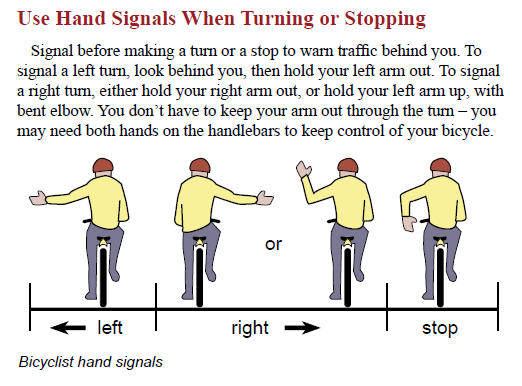Oregon law requires bicyclists to signal their turns and stops. While that seems like a simple proposition, this law actually goes deeper than that and contains some key differences from the signaling requirements of motor vehicle operators.
Turning
ORS 814.440 Failure to signal turn requires a person operating a bicycle to signal their turns, and ORS 811.395 Appropriate signals for stopping, turning, changing lanes and decelerating provides the method for doing so:
100 feet prior to a left turn a bicyclist must indicate their turn by extending their hand and arm horizontally from the left side of the bicycle.
100 feet prior to a right turn a bicyclist must indicate their turn by either extending their hand and arm upward from the left side of the bicycle or extending their right hand and arm horizontally from the right side of the bicycle.
Stopping
Like turning, the appropriate signal for stopping is contained in ORS 814.440 and ORS 811.395:
100 feet prior to executing a stop a bicyclist must continuously extend their hand and arm downward from the left side of the vehicle.
This differs from the turn signals because of the continuous requirement.
Once a bicyclist stops, they are required to then signal their turn while stopped before executing the turn.
Safety exception
Oftentimes safely braking requires the use of both hands, or conditions make removing an operator’s hands from the handlebars dangerous while approaching and making a turn. Because of those risks the law provides an important exception to the signaling requirements: bicyclists are not required to provide a signal if “circumstances require that both hands be used to safely control or operate the bicycle.”
Changing lanes
Oregon law requires one type of signal by motor vehicle operators that it does not require of bicyclists: changing lanes.
All vehicles are required under Oregon law to provide the appropriate signal when changing lanes and this law would apply to bicyclists under ORS 814.400 Application of vehicle laws to bicycles. However, ORS 814.400 exempts those laws that by “their very nature can have no application.” ORS 811.395 requires a change of lane to be signaled only by “activation of both front and rear turn signal lights on the side of the vehicle”. Bicycles do not have turn signal lights and are not required to have any lights beyond those required by ORS 815.280 Violation of bicycle equipment requirements (see ORS 811.525 Exemptions from requirements for use of lights). If a bicycle did have side turn signal lights, as some custom bikes have or have been retrofitted, then their operators would be required to signal a lane change using those lights.
For the rest of us, since by ORS 811.395(4)’s very nature it cannot apply to bicycle operators, a bicyclist is not required to signal a lane change. What this means is that a bicycle operator in Oregon cannot be issued a valid violation for failing to signal a lane change. However, ORS 814.400(3) provides that the vehicle code “does not relieve a bicyclist or motorist from the duty to exercise due care”.

